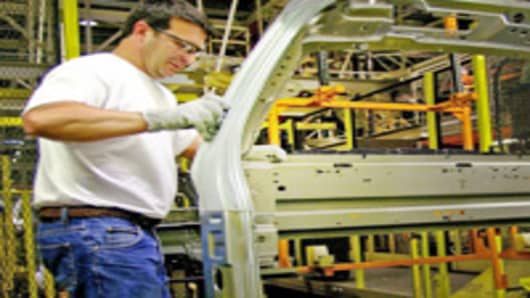June's surprise pickup in manufacturing activity makes it more likely the economy's soft patch is the result of temporary forces, and growth should pick up in the second half, economists say.
But that is where the agreement among economists ends, with forecasters split on what level of growth can be achieved. Some still see a paltry 2 percent, which would not produce jobs, while others are closer to 3.5 percent for the second half.
The Institute for Supply Management said Friday its index of manufacturing activity rose to 55.3 in June, from May's 53.5, which had been the slowest rate in 20 months. The June level surpassed economists' expectations of 51.8, triggering another move upin an already rallying stock market.
"Today's ISM report helps make the case even clearer that the economy was affected by the disruption from the Japanese disaster and it's possible there's going to be some elements of strength from the recovery that are even earlier than we expected," said Citigroup economist Steven Wieting.
The impact on the auto industry resulted in a shutdown in production and the loss of sales, as shipments of vehicles and parts from Japan were curtailed after the earth quake and tsunami.
Economists urge caution about the ISM number, however, since some of the components are less robust than the headline suggests. For instance, production edged up just slightly to 54.5 from 54. New orders were up slightly to 51.6 from 51 in May, while order backlog slipped to 49 from 50.5.
The index got a boost from a jump in inventories to 54.1 from 48.7, while prices paid slipped to 68 in June from 76.5 in May, as commodities pricesfell. A positive was the employment index, which rose to 59.9 form 58.2.
"The details weren't spectacularly good. The order index was just above 50. The blacklog of orders fell slightly. Most of the improvement came from higher inventories, compared to what we were seeing," said Nigel Gault, IHS Global Insight chief U.S. economist.
"This is still pointing to growth, so that's good news, and it will encourage hopes that the negative effects of high commodities prices and of Japan's natural disaster may be starting to ease some, and that we can look for better growth in the second half."
The next hurdle for markets is the June jobs report, expected next Friday. Economists are setting their sights low, and several have expectations for 100,000 jobs created in June.
"100,000 is still lackluster, but it's better than 54,000 (May) and it's a move in the right direction. If we're right about the economy doing better in the second half, employment growth is expected to improve and go to the 150,000-200,000 area" later in the summer, Gault said.
Gault expects second half growth of 3.5 percent, up from the 2 percent he expects for the second quarter. First quarter growth was revised up to 1.9 percent.
"We're going to have to see better reports than this (ISM) if we're going to see 3.5 percent in the second half. This does not seal the case. It is a report that will be consistent with that view, but it's not proof," he said.
RDQ chief economist John Ryding sees the report largely as a sign of less deterioration. "The plunge in the May ISM was alarming and it is somewhat reassuring to see this partial rebound in June. However, the details of the report were far less strong than the headline index as 1.1 point of the 1.8-point gain in the overall index came from an inventory build by manufacturers and customer inventories are much closer to being at desired levels than they have been in over two years," he wrote in a note.
"Easing inflation pressures likely reflect lower energy prices and a pullback in some industrial commodity prices (but at 68, these input cost pressures are still very significant). We score this report as arguing strongly against a further deterioration in growth but more agnostic between the view that the economy is in a soft patch from which it will strengthen (our baseline forecast) and the view that the expansion pace of growth has downshifted to 2 percent-2.5 percent," he wrote.
Questions? Comments? Email us at marketinsider@cnbc.com




